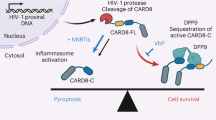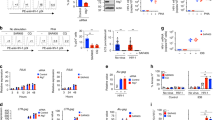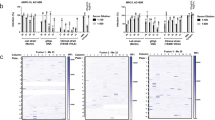Abstract
It is projected that in the absence of effective therapy, most individuals infected with human immunodeficiency virus (HIV) will develop acquired immune deficiency syndrome (AIDS) and ultimately succumb to a combination of opportunistic microbial infections, malignancies and direct pathogenic effects of the virus1–3. Anti-viral agents, immunomodulators, and inhibitors of specific HIV functions are being tested as potential treatments to alleviate the high morbidity and mortality4. An alternative therapeutic concept involves the development of cytotoxic agents that are targeted to kill HIV-infected cells. Here we describe the purification and characterization of a recombinant protein produced in Escherichia coli that contains the HIV-binding portion of the human CD4 molecule linked to active regions of Pseudomonas exotoxin A. This hybrid protein displays selective toxicity toward cells expressing the HIV envelope glycoprotein and thus represents a promising novel therapeutic agent for the treatment of AIDS.
This is a preview of subscription content, access via your institution
Access options
Subscribe to this journal
Receive 51 print issues and online access
$199.00 per year
only $3.90 per issue
Buy this article
- Purchase on Springer Link
- Instant access to full article PDF
Prices may be subject to local taxes which are calculated during checkout
Similar content being viewed by others
References
Anderson, R. M. & May, R. M. Nature 333, 514–518 (1988).
Levy, J. A. Nature 333, 519–522 (1988).
Fauci, A. S. Science 239, 617–622 (1988).
Mitsuya, H. & Broder, S. Nature 325, 773–778 (1987).
Pastan, I., Willingham, M. C. & FitzGerald, D. J. Cell 47, 641–648 (1986).
Chaudhary, V. K., FitzGerald, D. J., Adhya, S. & Pastan, I. Proc. natn. Acad Sci. U.S.A. 84, 4538–4542 (1987).
Lorberboum-Galski, H., FitzGerald, D., Chaudhary, V., Adhya, S. & Pastan, I. Proc natn. Acad. Sci. U.S.A. 85, 1922–1926 (1988).
Littman, D. R. A. Rev. Immun. 5, 561–584 (1987).
Sattentau, Q. J. & Weiss, R. A. Cell 52, 631–633 (1988).
Smith, D. H. et al. Science 238, 1704–1707 (1987).
Fisher, R. A. et al. Nature 331, 76–78 (1988).
Hussey, R. E. et al. Nature 331, 78–81 (1988).
Deen, K. C. et al. Nature 331, 82–84 (1988).
Traunecker, A., Luke, W. & Karjalainen, K. Nature 331, 84–86 (1988).
Berger, E. A., Fuerst, T. R. & Moss, B. Proc. natn. Acad. Sci. U.S.A. 85, 2357–2361 (1988).
Chakrabarti, S., Robert-Guroff, M., Wong-Staal, F., Gallo, R. C. & Moss, B. Nature 320, 535–537 (1986).
Hu, S., Kosowski, S. G. & Dalrymple, J. M. Nature 320, 537–539 (1986).
Lifson, J. D. et al. Nature 323, 725–728 (1986).
Middlebrook, J. L. & Dorland, R. B. Microbiol. Rev. 48, 199–221 (1984).
Folks, T. M. et al. J. exp. Med. 164, 280–290 (1986).
Gendelman, H. E. et al. Virology 160, 323–329 (1987).
Biddison W. E. & Shaw, S. Diagnostic Immun. 1, 112–115 (1983).
Romain, P. L., Schlossman, S. F. & Reinherz, E. J. Immun. 133, 1093–1100 (1984).
Gay, D. et al. Nature 328, 626–629 (1987).
Doyle, C. & Strominger, J. L. Nature 330, 256–259 (1987).
Sattentau, et al. AIDS 2, 101–105 (1988).
Coffin, J. M. Cell 46, 1–4 (1986).
Studier, F. W. & Moflatt, B. A. J. molec. Biol. 189, 113–130 (1986).
Chaudhary, V. K., Xu, Y., FitzGerald, D., Adhya, S. & Pastan, I. Proc. natn. Acad. Sci. U.S.A. 85, 2939–2943 (1988).
Collier, R. J. & Kandel, J. J. biol. Chem. 246, 1496–1503 (1971).
Laemmli, U. K. Nature 227, 680–685 (1970).
Fuerst, T. R., Niles, E. G., Studier, F. W. & Moss, B. Proc. natn. Acad. Sci. U.S.A. 83, 8122–8126 (1986).
Author information
Authors and Affiliations
Rights and permissions
About this article
Cite this article
Chaudhary, V., Mizukami, T., Fuerst, T. et al. Selective killing of HIV-infected cells by recombinant human CD4-Pseudomonas exotoxin hybrid protein. Nature 335, 369–372 (1988). https://doi.org/10.1038/335369a0
Received:
Accepted:
Issue Date:
DOI: https://doi.org/10.1038/335369a0
This article is cited by
-
Furin-dependent CCL17-fused recombinant toxin controls HTLV-1 infection by targeting and eliminating infected CCR4-expressing cells in vitro and in vivo
Retrovirology (2015)
-
Novel bacterial ADP-ribosylating toxins: structure and function
Nature Reviews Microbiology (2014)
-
Selective killing of HIV-1-positive macrophages and T cells by the Rev-dependent lentivirus carrying anthrolysin O from Bacillus anthracis
Retrovirology (2008)
-
Targeted infection of HIV-1 Env expressing cells by HIV(CD4/CXCR4) vectors reveals a potential new rationale for HIV-1 mediated down-modulation of CD4
Retrovirology (2005)
-
Specific Killing of HIV-infected Lymphocytes by a Recombinant Immunotoxin Directed against the HIV-1 Envelope Glycoprotein
Molecular Medicine (1998)
Comments
By submitting a comment you agree to abide by our Terms and Community Guidelines. If you find something abusive or that does not comply with our terms or guidelines please flag it as inappropriate.



